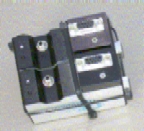
Field Spectroradiometry :: Spectral Libraries :: Hardware :: Publications :: Gallery
Field Spectroradiometry Equipment
This page provides descriptions of the field spectroradiometry systems used for lake
studies at the UW-Madison Environmental Remote Sensing Center.
|

|
ASD FieldSpec This Analytical Spectral Devices (ASD) FieldSpec hand-held portable spectroradiometer was ERSC's first field spectroradiometer, acquired in May 2001. It has a wavelength range of operation spanning from 325 nm to 1075 nm, which is ideal for water quality applications. The instrument incorporates a spectral resolution of 3.5 nm and a 1.6 nm-sampling interval. It captures multiple spectra per second, allowing real-time display of spectral data, with integration times as low as 17 ms. An RS-232 serial interface provides for laptop control, display, and data collection. The instrument operates by comparing radiance from the surface of the lake to radiance from a near-Lambertian reference disc. These two observations must be taken close together in time, and if atmospheric conditions change appreciably during this period, the calculated spectral reflectance data will be biased. The entire apparatus is portable enough to be taken on a small boat or canoe and operated by a single person. Protocol (pdf): Nordheim, M.J. 2002. Development of a Protocol for Use of a Field Spectroradiometer in Monitoring Lake Water Quality. Unpublished technical report, Environmental Remote Sensing Center, University of Wisconsin-Madison. |

|
Ocean Optics USB2000 Dual Spectroradiometer System In August 2003 we acquired a new system, consisting of two Ocean Optics USB-2000 spectrometers. This system permits simultaneous measurement of downwelling solar irradiance and upwelling reflected radiance, in order to accurately derive spectral reflectance. Each of the two spectrometers measures only 8.9 cm by 6.3 cm by 3.4 cm and has 2048 spectral bands from 339.99 nm to 1023.9 nm. The system has a signal-to-noise ratio of 250:1 at full signal. It includes fiber-optic cables to collect incoming radiation, calibration using a 99% white reference standard, and multiple serial and USB connections to the controlling computer, which runs the CDAP software package developed at the University of Nebraska. Data output includes both radiance and reflectance. An advantage of this system for lake monitoring is that the fiber-optic cable can be used to collect upwelling radiance either above or below the surface of the water. Protocol (pdf): Nordheim, M.J. 2004. Using the Ocean Optics Spectroradiometer . Unpublished technical report, Environmental Remote Sensing Center, University of Wisconsin-Madison. |


